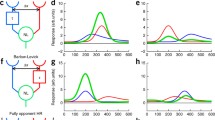Abstract
A biologically inspired visual system capable of motion detection and pursuit motion is implemented using a Discrete Leaky Integrate-and-Fire (DLIF) neuron model. The system consists of a visual world, a virtual retina, the neural network circuitry (DLIF) to process the information, and a set of virtual eye muscles that serve to move the input area (visual field) of the retina within the visual world. Temporal aspects of the DLIF model are heavily exploited including: spike propagation latency, relative spike timing, and leaky potential integration. A novel technique for motion detection is employed utilizing coincidence detection aspects of the DLIF and relative spike timing. The system as a whole encodes information using relative spike timing of individual action potentials as well as rate coded spike trains. Experimental results are presented in which the motion of objects is detected and tracked in real and animated video. Pursuit motion is successful using linear and also sinusoidal paths which include object velocity changes. The visual system exhibits dynamic overshoot correction heavily exploiting neural network characteristics. System performance is within the bounds of real-time applications.
Similar content being viewed by others
Explore related subjects
Discover the latest articles, news and stories from top researchers in related subjects.References
Risinger L, Kaikhah K (2004) Modified bifurcating neuron with leaky-integrate-and-fire model. In: Seventeenth international conference on industrial & engineering applications of artificial intelligence & expert systems (IEA/AIE), May 2004
Koch C (1999) Biophysics of computation: information processing in single neurons. Oxford University Press, Oxford
Rao RPN (2004) Bayesian computation in recurrent neural circuits. Neural Comput 16(1):1–38
Lee G, Farhat N (2002) The bifurcating neuron network 2: an analog associative memory. Neural Netw 15:60–84
Eldefrawy M, Farhat N (1992) The bifurcating neuron: characterization and dynamics. In: Photonics for computers, neural networks and memories. SPIE proceedings, vol 1773, pp 23–34
Hopfield JJ, Brody CD, Roweis S (1998) Computing with action potentials. In: Neural information processing systems 10. MIT Press, Cambridge, pp 166–172
Hopfield JJ (1995) Pattern recognition computation using action potential timing for stimulus representation. Nature 376:33–36
Smith LS, Fraser DS (2004) Robust sound onset detection using leaky integrate-and-fire neurons with depressing synapses. IEEE Trans Neural Netw 15(5):1125–1134
Shepard GM (2004) The synaptic organization of the brain, 5th edn. Oxford University Press, Oxford
Kandel ER, Schwartz JH, Jessel TM (1995) Essentials of neuroscience and behavior. Appleton & Lange, Connecticut
Bear MF, Connors BW, Paradise MA (2001) Neuroscience: exploring the brain, 2nd edn. Williams & Wilkins, Maryland
Sonka M, Hlavac V, Doyle R (1999) Image processing, analysis and machine vision, 2nd edn. PWS, New York
Mehrotra K, Mohan C, Ranka S (1997) Elements of artificial networks. MIT Press, Cambridge
Leventhal AG (1991) Vision and visual dysfunction, vol 4: the neural basis of visual function. Macmillan, Baton, FL
Saul AB, Humphrey AL (1992) Evidence of input from lagged cells in the lateral geniculate nucleus to simple cells in cortical area 17 of the cat. J Neurophysiol 68:1190–1208
Clifford CW, Ibbotson MR (2003) Fundamental mechanisms of visual motion detection: models, cells and functions. Prog Neurobiol 68:409–437
Beare R, Bouzerdoum A (1999) Biologically inspired local motion detector architecture. Opt Soc Am 16:9:2059–2068
Missler JM, Kamangar FA (1995) A neural network for pursuit tracking inspired by the fly visual system. Neural Netw 8:3:463–480
Dacey DM, Peterson MR (1992) Dendritic field size and morphology of midget and parasol ganglion cells of the human retina. Proc Natl Acad Sci 89:9666–9670
Koch C (2004) The quest for consciousness: a neurobiological approach. Roberts & Company, Englewood
Rieke F, Warland D, et al. (1999) Spikes exploring the neural code. MIT Press, Cambridge
VanRullen R, Thorpe SJ (2002) Surfing a spike wave down the ventral stream. Vis Res 42(23):2593–2615
Author information
Authors and Affiliations
Corresponding author
Rights and permissions
About this article
Cite this article
Risinger, L., Kaikhah, K. Motion detection and object tracking with discrete leaky integrate-and-fire neurons. Appl Intell 29, 248–262 (2008). https://doi.org/10.1007/s10489-007-0092-9
Received:
Accepted:
Published:
Issue Date:
DOI: https://doi.org/10.1007/s10489-007-0092-9




